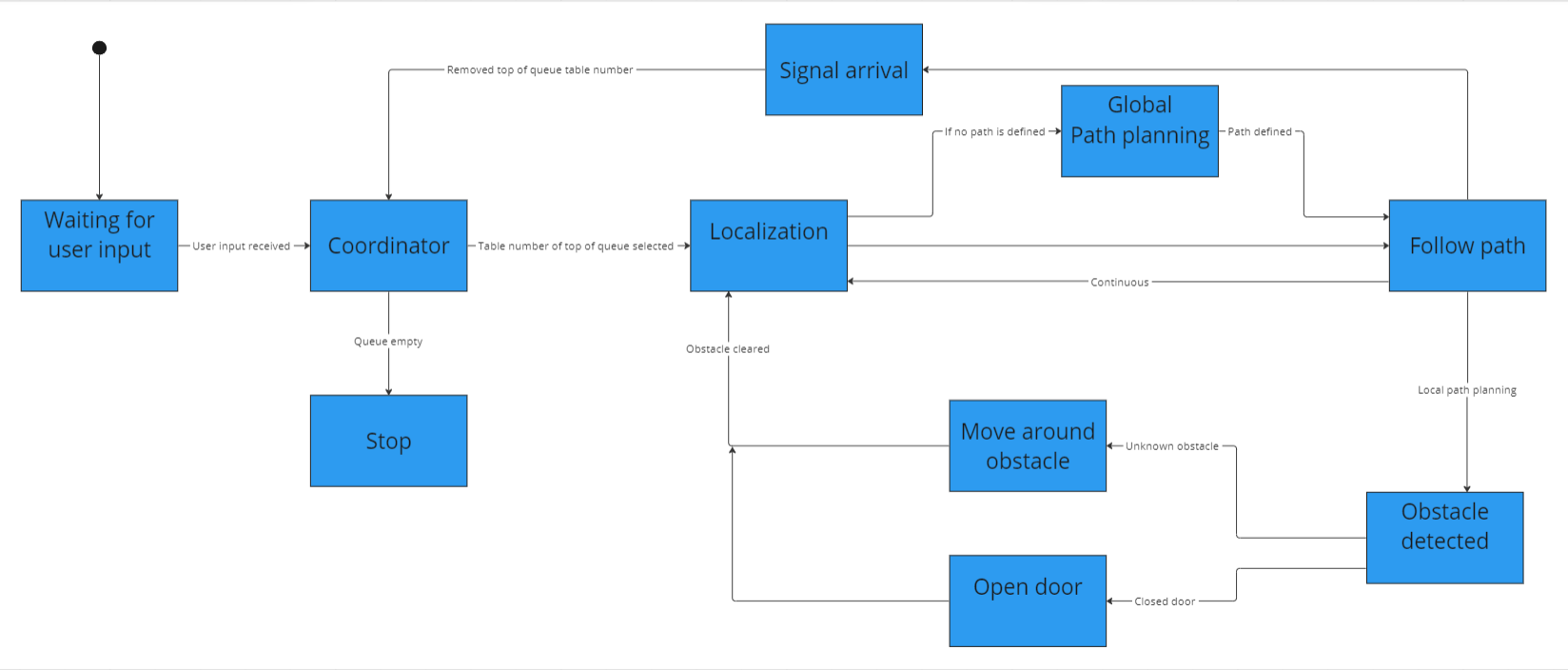Mobile Robot Control 2023 Wall-E
Group members:
| Name | student ID |
|---|---|
| Lars Blommers | 1455893 |
| Joris Bongers | 1446193 |
| Erick Hoogstrate | 1455176 |
| Noortje Hagelaars | 1367846 |
| Merlijn van Duijn | 1323385 |
| Sjoerd van der Velden | 1375229 |
Task description
| Name | Tasks week 8 | Tasks week 9 |
|---|---|---|
| Lars Blommers | 1. Localisation (particle filter) | |
| Joris Bongers | 1. Navigation (combining global
and local navigation) |
|
| Erick Hoogstrate | 1. Localisation (particle filter) | |
| Noortje Hagelaars | 1. Adjust state and data diagram
after feedback from tutors 2. Navigation (A* algorithm) |
|
| Merlijn van Duijn | 1. Navigation (A* algorithm) | |
| Sjoerd van der Velden | 1. Adjust state and data diagram
after feedback from tutors 2. Navigation (combining global and local navigation) |
Design presentation
State flow diagram
Data flow diagram
Function description
In this paragraph every function is discussed. The input and output data and the way this data is processed are the main aims of this paragraph.
User input
Inputs: User defined sequence of numbers inputted through terminal
Outputs: Array with table numbers in correct order
This is a simple function that requests the sequence of table numbers as a user input. It then converts these numbers into an array where every index of the array is a table number.
Coordinator
Inputs: Array with table numbers, Signal that the robot has arrived at the table
Outputs: Table number, Stop signal
The coordinator keeps track of the table number that the robot has as goal. Once the robot arrives at this table, the coordinator sets the next table in the queue as the new goal. Once all tables have been visited, it stops the robot.
Localization
Inputs: Laser data, odometer data, map data
Outputs: xy position of robot, rotation of robot
This function is the heart of the system. It takes the laser, odometer and map data and combines them to determine the position of the robot with regards to the map. It uses the ParticleFilter as designed in the exercises to achieve this goal.
Global Path planning
Inputs: Node locations, Current position of the robot, Goal table number
Outputs: Sequence of nodes for Path
The global path planning function makes use the A* algorithm as defined in the exercises. It looks at the current position of the robot and calculates a path through predefined nodes. It sends the sequence of nodes that the robot needs to follow to arrive at the goal.
Follow path
Inputs: Location of the robot, Sequence of nodes for Path.
Outputs: control commands for robot
When the sequence of nodes is defined, this function makes sure the robot moves from node to node until it reaches its goal. It uses either the open spaces or artificial vector field approach for this.
Obstacle detected
Inputs: laser data
Outputs: control commands for robot
When an object is in the path of the robot, it needs to be avoided. This function will take care of that. It overrules the path following function.
Signal arrival
Inputs: location of the robot, location of the table
Outputs: Sound message, signal to coordinator to set next table as goal.
This function looks if the robot has arrived at the table by calculation the distance between the robot and the table. Once this value is under a certain threshold, a sound message is sent to the robot and the coordinator is informed that the robot has reached the table.
